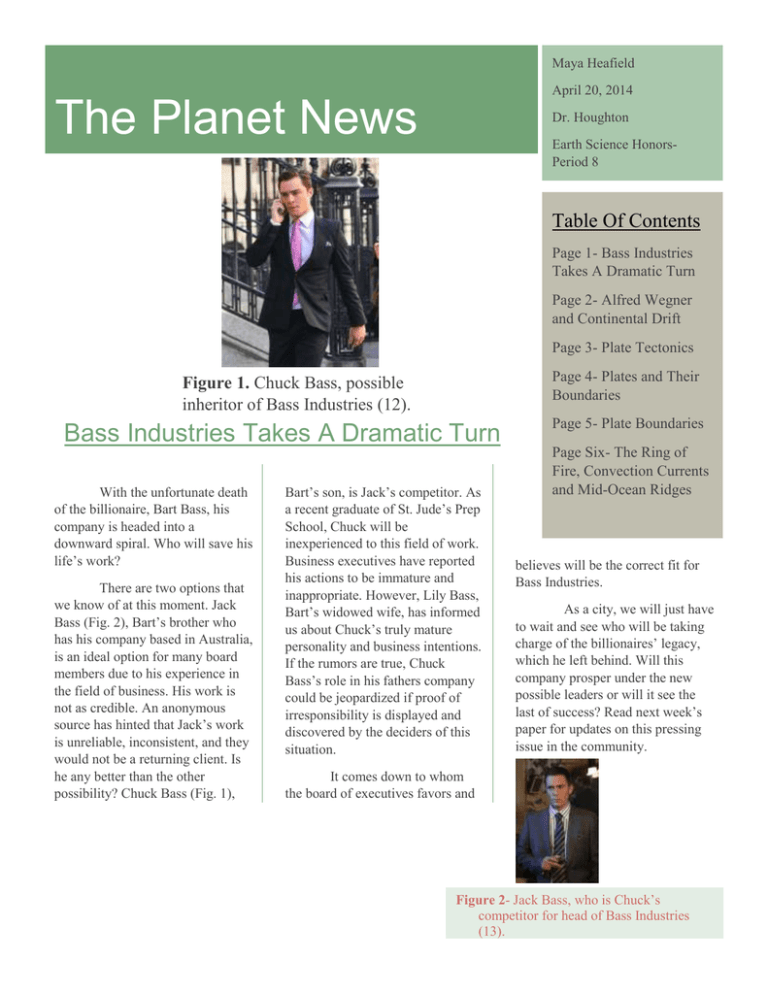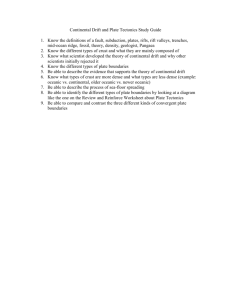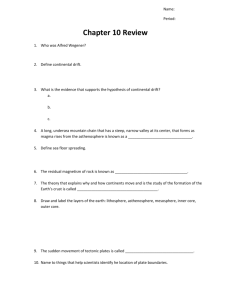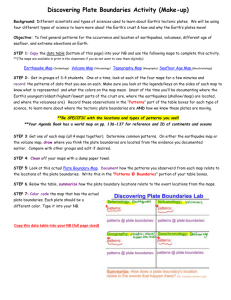
Maya Heafield
April 20, 2014
The Planet News
Dr. Houghton
Earth Science HonorsPeriod 8
Table Of Contents
Page 1- Bass Industries
Takes A Dramatic Turn
Page 2- Alfred Wegner
and Continental Drift
Page 3- Plate Tectonics
Page 4- Plates and Their
Boundaries
Figure 1. Chuck Bass, possible
inheritor of Bass Industries (12).
Bass Industries Takes A Dramatic Turn
With the unfortunate death
of the billionaire, Bart Bass, his
company is headed into a
downward spiral. Who will save his
life’s work?
There are two options that
we know of at this moment. Jack
Bass (Fig. 2), Bart’s brother who
has his company based in Australia,
is an ideal option for many board
members due to his experience in
the field of business. His work is
not as credible. An anonymous
source has hinted that Jack’s work
is unreliable, inconsistent, and they
would not be a returning client. Is
he any better than the other
possibility? Chuck Bass (Fig. 1),
Bart’s son, is Jack’s competitor. As
a recent graduate of St. Jude’s Prep
School, Chuck will be
inexperienced to this field of work.
Business executives have reported
his actions to be immature and
inappropriate. However, Lily Bass,
Bart’s widowed wife, has informed
us about Chuck’s truly mature
personality and business intentions.
If the rumors are true, Chuck
Bass’s role in his fathers company
could be jeopardized if proof of
irresponsibility is displayed and
discovered by the deciders of this
situation.
Page 5- Plate Boundaries
Page Six- The Ring of
Fire, Convection Currents
and Mid-Ocean Ridges
believes will be the correct fit for
Bass Industries.
As a city, we will just have
to wait and see who will be taking
charge of the billionaires’ legacy,
which he left behind. Will this
company prosper under the new
possible leaders or will it see the
last of success? Read next week’s
paper for updates on this pressing
issue in the community.
It comes down to whom
the board of executives favors and
Figure 2- Jack Bass, who is Chuck’s
competitor for head of Bass Industries
(13).
The Planet News
Alfred Wegner
The other day, I had the amazing
opportunity to sit down with Alfred
Wegner himself (Fig. 1), who is
responsible for developing the continental
drift hypothesis. With this great
opportunity, I needed to ask him a few
questions.
Q: What does your hypothesis state?
A: My hypothesis proposes the idea that
the continents had once been joined, and
over time had drifted apart (1).
Q: How did you come to this conclusion?
A: I came up with four lines of evidence.
First, while observing the continents, I
found that South America and Africa had
matching coastlines (1). Second, I found
coal deposits in northern regions. The
fossils associated with the deposits are
from plants commonly associated with
tropical climates (1). At the same time, I
found glacial grooves located in the
African plains. This suggested that the
northern continents likely were connected
and located near the equator, while the
southern continents also likely were
connected and located closer to the South
Pole (1). Third, I found similar fossils on
all the continents 300 mya. This suggests
that the continents likely were connected
(1). Lastly, Matching mountain ranges
Q: How did people react to your
hypothesis?
A: Most people that I had presented my
ideas to continually criticized and
attempted disprove my work, although
their contradicting theories were more
absurd than mine (1).
Q: Now tell me, what did your hypothesis
need to be accepted?
A: I realize now that what I needed was a
way to explain WHY exactly the
continents had moved. My work required
a mechanism (1).
Figure 1. Alfred Wegner, creator of the
continental drift hypothesis (9).
That was the science piece
of our interview with Wegner.
However we did discuss other
things about that had been a part
of his life. Wegner was born in
1880 and raised in Berlin (2). He
finished his studies in Germany
and Austria, eventually receiving
his PhD in Astronomy, however
he transitioned into meteorology
(2). Soon after he started attending
and leading expeditions in places
such as Greenland, he became a
teacher of meteorology at the
University of Marburg (2).
Additionally, he served time as a
soldier in World War 1, and after
that experience began publishing
works regarding his ideas on
Continental Drift (2).
The people during his time
were not very supportive of his
discoveries (1). Thankfully he has
continued to form and stand by his
hypothesis because scientists now
have learned and branched off of
his original thoughts.
kh
3
The Plate Tectonic Theory
Figure 1. Cartoon of
Earth Being Split Up
into Plates (10).
Did you know that the lithosphere is part of
the Earth’s crust, which is above the
asthenosphere? Until today I had no idea about
the theory of Plate Tectonics and how it is that
the lithosphere is divided into about twelve
major plates, with additional smaller ones, and
these plates move across Earth’s surface (4,
Fig. 1). An interview with Dr. Fan is the
reason that we have been enlightened with the
Plate Tectonic Theory.
There are four key pieces of evidence
that prove the Plate Tectonic Theory according
to him (4). Paleomagnetism is a piece, which
is defined as the natural reminisce of
magnetism left in rocks (5). The different ages
of these rocks shows us that the magnetism
has changed over the millions of years because
of the different magnetisms the rocks hold (5).
A Magnetometer is the device, similar to a
compass that detects changes in the magnetic
field which scientists like Dr. Fan use to
observe the magnetism of the Earth (5).
Dr. Fan also spoke about how people
originally believed that the ocean floor was
flat and featureless (4). However, deep-sea
line sounding experiments were conducted and
scientists discovered that the seafloor was
mountainous and diverse (6). Dr. Fan said that
as technology developed, echo-sounding
devices or sonar, were used to prove the size
and roughness of the ocean floor (5). The midAtlantic Ridge has also been a part in this
discovery (6).
Figure 2. Pangaea (11).
How did it start?
It all began with Pangaea (Fig. 2), one big
supercontinent that was made up of the seven
continents on planet earth today. About 200 million
years ago, Pangaea began to slowly break up and
spread across the world (3). These plates can be made
up of oceanic or continental crust when they converge.
Diverging and transform boundaries are another way
the plates move (4).
Seafloor spreading is another type of
proof used to support plate tectonics (4). Dr.
Fan said that this is when the new oceanic
crust is formed due to oceanic ridges and
plates spreading apart (5). Convection currents
take part in this process, bringing magma up to
the areas where the seafloor spreads (5). Also,
hotspots are plumes of magma that can make
up volcanic bodies, such as the Hawaiian
Islands. Different island chains and
landmasses are formed by hotspots, however
the hot spot does not move; the plate above it
does (5).
Earthquakes and volcanoes are part of
the plate tectonic puzzle. 90% of earthquakes
and volcanoes occur at plate boundaries (6).
Seismographs lead us to this knowledge about
earthquakes by pinpointing their epicenters
(6).
Plate Boundaries
Plates are what the Earth is made up of. The tectonic plates float on top of the
lithosphere, part of the Earth’s crust. These plates have three types of boundaries; transform,
divergent and divergent (7). An interview from Bill Nye aided us learning about these
boundaries.
He explained to us about how transform boundaries occur when two plates slide past
each other, and result in faults (7, Fig. 2). Anything on the fault line, man-made or natural,
are ruined or are split in opposite directions. Nye described that rocks are pulled along the
boundary and this creates a jagged edged fault valley (7). Also, transform boundaries are
followed with earthquakes, sending out seismic waves due to the plates moving against each
other (7). According to him, magma is formed when plates transform, in contrast to divergent
and convergent boundaries (7).
Figure 1. continentalcontinental convergent
boundary resulting in a
mountain (8).
Additionally, he enlightened us about how diverging boundaries occur when two
plates move away from one another (Fig. 2). Lava is brought up along these boundary types
under a rift, creating new crust where the plates’ edges have been torn (7). This magma
eventually cools, becoming basaltic rock and new oceanic crust. Earthquakes do strike
divergent boundaries frequently (7). Mid-ocean ridges and rift valleys are a feature of this
type of boundary (7).
Bill also told us about the converging boundaries take place when two plates come
together. There are three situations of convergent boundaries relating to the type of crust
colliding; continental-continental, continental-oceanic and oceanic-oceanic (Fig. 2). Oceanicoceanic convergent boundaries are highly dense so they subduct, creating subduction zones,
ocean trenches and volcanic island chains (7). I learned that earthquakes and volcanoes could
also occur after plates converge at a continental-oceanic boundary. At a continental-oceanic
converging boundary, the oceanic crust (high density) is forced under the continental crust
(low density) and the oceanic crust begins to melt. Next, magma rises and solidifies into new
crust, and forms into granite continental crust, while the oceanic crust has been “recycled”
(7). Continental-continental converging boundaries are when two low-density plates come
together and form large non-volcanic mountain ranges (7, Fig. 1).
With Bill Nye’s knowledge, the news team and I think about the world,
earthquakes, and continents differently. I now think about the plates underneath us
could be and probably are moving.
Figure 2-. Map displaying the different types of plate
boundaries all over the world (14).
Our team of reporters visited a high school class. This class was an Earth science class.
We asked the students what they were learning about and if they could teach us a few
things about how the world works. Luckily, they did and we learned some interesting
things, specifically about mid-ocean ridges, convection currents and The Ring of Fire.
Using the students’ knowledge and great teaching skills, we were able to bring you these
short articles, crediting the students.
Mid-Ocean Ridges
Convection Currents
A mid-ocean ridge, formed
by plate tectonics and divergent
boundaries, is an underwater
mountain range (15). These midocean ridges are all connected to
form a single global mid-oceanic
ridge system that is part of every
ocean. It is the largest mountain
range in the world, totaling at
60,000 km in length (15).
Ridge-push, when the
weight of the ridge pushes the rest
of the plate away, and slab-pull, the
weight of the tectonic plate being
pulled below the plate, are thought
to be responsible for the spreading
seen at mid-ocean ridges (15).
The mantle is the
outermost part of the Earth,
other than the crust, and is
made of dense, thick material
(16,17). Some scientists believe
that the mantle “flows” due to
convection currents (16).
Convection currents are caused
by the deepest part of the
mantle rising, cooling, sinking,
heating up and repeating over
and over (17). These
convection currents flowing
also cause the crust to move,
which moves the plates as well
(16).
The Ring of Fire
The Ring of Fire is a chain of volcanoes surrounding the
Pacific Plate resulting from subduction of oceanic plates beneath less
dense continental plates (17). John Smith, a German scientist
explained the reason so many of the Earth’s volcanoes occur here is
because of the extensive subduction taking place around this plate
(17). He reviewed with us about subduction, when water is taken
down with the plate and heats up and rises. Water and other
substances cause the mantle to begin to melt which produces magma.
The magma rises and erupts, giving you a volcano (17). With these
volcanoes erupting, you can either get a mountain chain of volcanoes
or an island chain of volcanoes (17).
Works Cited
1. Sant, Joseph. "Wegener and Continental Drift Theory." Wegener and Continental Drift Theory.
Sant, n.d. Web. 20 Apr. 2014.
Joseph
2. "Alfred Wegner." PBS. PBS, n.d. Web. 19 Apr. 2014
3. "Intro To The Plate Tectonic Theory." PBS. PBS, n.d. Web. 19 Apr. 2014.
4. "Plate Tectonic Theory: Plates and Interplate Relationships." Plate Tectonic Theory: Plates and Interplate
Relationships. N.p., n.d. Web. 20 Apr. 2014.
5. Murphy. "Unit 7 Earth Science." Plate Tectonics|. Web.
<http://mhs.wcpss.net/teachers/murphy/earthscience/notes/platetectonics/Unit 7 Part A Intro Notes.pdf>.
6. "Developing the Theory [This Dynamic Earth, USGS]." Developing the Theory [This Dynamic Earth,
USGS]. N.p., n.d. Web. 19 Apr. 2014.
7. "There Are Three Kinds of Plate Tectonic Boundaries: Divergent, Convergent, and Transform Plate
Boundaries." NOAA Ocean Explorer Podcast RSS. N.p., n.d. Web. 21 Apr. 2014.
8. Convergent Plate. N.d. Web. 19 Apr. 2014.
9. Alfred Wegner. N.d. Web. 19 Apr. 2014.
10. Plate Boundaries. N.d. Web. 19 Apr. 2014. Pangea. N.d. Web. 19 Apr. 2014.
11. Gossip Girl. N.d. Web. 19 Apr. 2014.
12. Jack Bass. N.d. Web. 19 Apr. 2014.
13. Plate Puzzle. N.d. Web. 19 Apr. 2014.
14. "Mid-ocean Ridge." ScienceDaily. ScienceDaily, n.d. Web. 22 Apr. 2014.
15. "Convection Currents." Volcano Oregon State. N.p., n.d. Web. 22 Apr. 2014.
16. "What Is the "Ring of Fire?" | Volcano World." What Is the "Ring of Fire?" | Volcano World. N.p., n.d.
Web. 22 Apr. 2014.
17. Tarbuck, Edward J., Frederick K. Lutgens, and Dennis Tasa. Prentice Hall Earth Science. Needham, Mass. ;
Upper Saddle River, N.J.: Pearson/Prentice Hall, 2006. Print.
Possible
points
1. Title banner - assertive, clear, & eye-catching; easily read from at
least 5 ft. Title banner promotes selling of news.
5
2. Name - date, period, class, teacher located on back top right hand
corner
10
3. Text & figures integrated; text hierarchically organized & the hierarchy
differentiated visually; easy for reader to proceed in proper order from
section to section
10
3. Layout – columnar, appropriate use of colored borders & bullets
10
4. Graphics – accompanied by a caption, no non-essential information;
all components clearly visible.
20
5. Writing – active, written from the standpoint of the author. Writing
includes interviews with important historic characters or fake people.
20
6. Content –
25
a. Article about Alfred Wegener and his theory of continental drift
describing and listing the evidence that led Wegener to believe that
the continents were once together. Must include an illustration or
picture.
b. Article about the theory of plate tectonics describes the theory to
your readers and includes an illustration or picture.
25
c. Article describes the different types of plate boundaries, including,
Divergent boundaries, Oceanic – continental convergent boundaries,
Oceanic – oceanic convergent boundaries, Continental – continental
convergent boundaries, transform boundaries. You included a
location on the earth of each type of boundary (text or map) and at
least 2 pictures with the article.
25
d. Article with your choice of some topics related to plate tectonics.
Additional topics: Hot spots, Sea floor spreading, Pangaea,
Convection currents, Rift valleys, The Ring of Fire, Mid – Ocean
ridge.
25
7. 4 sources using proper MLA citation. At least one source was a book.
Proper use of in text citations.
25
Points
Total
200









